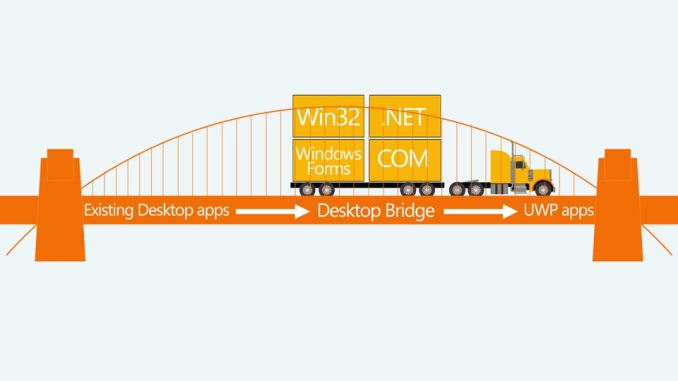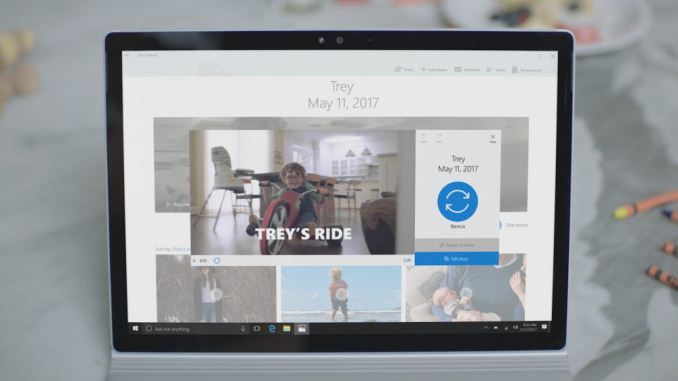The Microsoft Build 2017 Recap: What To Expect When You’re Expecting Windows
by Brett Howse on May 19, 2017 8:00 AM ESTWindows Store and UWP Updates
The Windows Store has never really gained the traction that Microsoft was hoping for, despite Windows 10 now on over 500 million devices. With Windows 10 S, which only allows Store installs (but can be upgraded to Windows 10 Pro for full app compatibility) Microsoft is hoping they can drive some more applications to the store. They’ve announced a lot of tools over the last couple of years to make it as easy as possible to get developers to move to the store, and there are significant advantages to both users and developers for having a system where they app is easily found, downloaded, and updated, but despite this it’s still been a challenge to drive developers to lock into UWP.
Part of that is that the sales pitch for UWP was to get apps to be available across different device types, and with the low usage share of Windows in the smartphone world, that was going to be a difficult sell. UWP needed to be aimed more at the desktop earlier, but regardless, a developer could target all of the Windows install base of over 1 billion machines by building a Win32 app, or just target Windows 10 installs with a UWP store app.
Possibly the biggest saving grace for Microsoft’s Store efforts got announced at Build last year, with Project Centennial, which was later branded the Desktop App Converter. This simple tool allows most apps to be quickly repackaged into a Store app, with few, or no, changes required to the app. This doesn’t make it a UWP app of course, but it does allow it to be put in the Store, updated through the Store, and includes the sandboxed security model of Store apps. It’s been a nice addition to the Windows arsenal, and Microsoft had seen some great desktop apps like Adobe Photoshop Elements come to the Store through this bridge.
At Build, Microsoft announced some other big apps coming through the Desktop Bridge. iTunes is coming to the Windows Store, which is kind of amazing when you think about it. The best part for Windows users who do use iTunes is that the app can’t do anything to your system, and if you install it, it’s all gone with none of the normal remnants lingering throughout the file system and registry. Autodesk is also bringing Stingray to the store, and SAP Digital Boardroom is also on its way. SAP is a big player in business, so for Microsoft to get Windows 10 S into the enterprise, these types of apps need to make their way into the store.
UWP also got some love at the conference, so even though the Desktop Bridge is going to be the carrot to get apps into the store, UWP needs to continue to improve in order to tempt developers to leverage its advantages. .NET Standard 2.0 for UWP was announced at Build, and XAML Standard will be available later on this year to help with cross-platform capabilities. With Microsoft’s purchase of Xamarin, it makes a lot of sense for them to try and leverage that purchase into further expanding UWP. .NET Standard is adding more than 20,0000 APIs to UWP, including the most requested APIs such as Reflection and SqlClient are coming with the Fall Creators Update.
The Store needs to continue to improve, and it does appear that Microsoft is getting some buy-in with some bigger companies, which is important. The Desktop Bridge for Windows continues to be a strong tool to remove some of the barriers to bringing an existing app into the new world without having to re-write the app from the ground up. It’ll be interesting to see how they progress between now and the Fall Creators Update.












85 Comments
View All Comments
close - Friday, May 19, 2017 - link
I'd guess you're not using Enterprise. The "test this app" experience might be MS's way of steering businesses towards Enterprise rather than Pro.Sivar - Friday, May 19, 2017 - link
I suspect the downloads are done by some third-party software.SaolDan - Friday, May 19, 2017 - link
I second thisclose - Saturday, May 20, 2017 - link
It's actually something MS included as "a feature". The content delivery manager with the pre-installed apps option. You can disable this in registry or local policy.As far as I know it comes in the Pro versions although some older MSDN Windows Enterprise ISOs came with it enables. I guess MS received enough feedback from enterprises to cut the crap so now they just try it on regular customers.
blakflag - Friday, May 19, 2017 - link
I would love it if all my apps could be fetched through the store. The problem is most of them are NOT UWP, and created by small developers (utilities and such). Hopefully MS has made it really easy to get apps into the store, because otherwise most of my apps will never be there.Meteor2 - Saturday, May 20, 2017 - link
I probable have 4-5 programmes beyond Chrome and Office, all but one open source, and none came through the app store. The App Store itself is mainly full of junk.blakflag - Sunday, May 21, 2017 - link
Yeah I know it is. I just wish it weren't. :) I actually find Chocolatey to be pretty useful for open source stuff, although I worry a lot about someone uploading a trojan package since it's much newer and less popular than Ubuntu repository for instance.blakflag - Friday, May 19, 2017 - link
The Linux subsystem is truly amazing stuff, and I already find it useful. Unfortunately there is no GPU-acceleration which is a buzzkill for me. Trying to learn machine learning techniques on Windows is really painful since the library support is not so great.Eden-K121D - Friday, May 19, 2017 - link
I really hope they follow through Fluent design language,Wide Color gamut, and HDR support.I really don't want my 2017 computer run a UI which looks horrible
BrokenCrayons - Friday, May 19, 2017 - link
I see no point in messing with Linux inside of Windows when I can simply use Linux atop bare metal and get the distro I want the way I prefer to use it. As well, I don't have to deal with always-on, Google-levels-of-creepy Cortana lurking and listening or non-removable OneDrive. The visual activity history is nice, but I'd hope it can be totally disabled. Knowing how MS works these days, probably not and it's likely part of their data mining efforts as they play catchup with Alphabet and others.